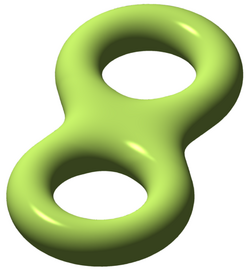Genus-two surface
From HandWiki
In mathematics, a genus-two surface (also known as a double torus or two-holed torus) is a surface formed by the connected sum of two tori. That is to say, from each of two tori the interior of a disk is removed, and the boundaries of the two disks are identified (glued together), forming a double torus.
This is the simplest case of the connected sum of n tori. A connected sum of tori is an example of a two-dimensional manifold. According to the classification theorem for 2-manifolds, every compact connected 2-manifold is either a sphere, a connected sum of tori, or a connected sum of real projective planes.
Double torus knots are studied in knot theory.
Example
The Bolza surface is the most symmetric Riemann surface of genus 2.
See also
- Triple torus
References
- James R. Munkres, Topology, Second Edition, Prentice-Hall, 2000, ISBN:0-13-181629-2.
- William S. Massey, Algebraic Topology: An Introduction, Harbrace, 1967.
External links


